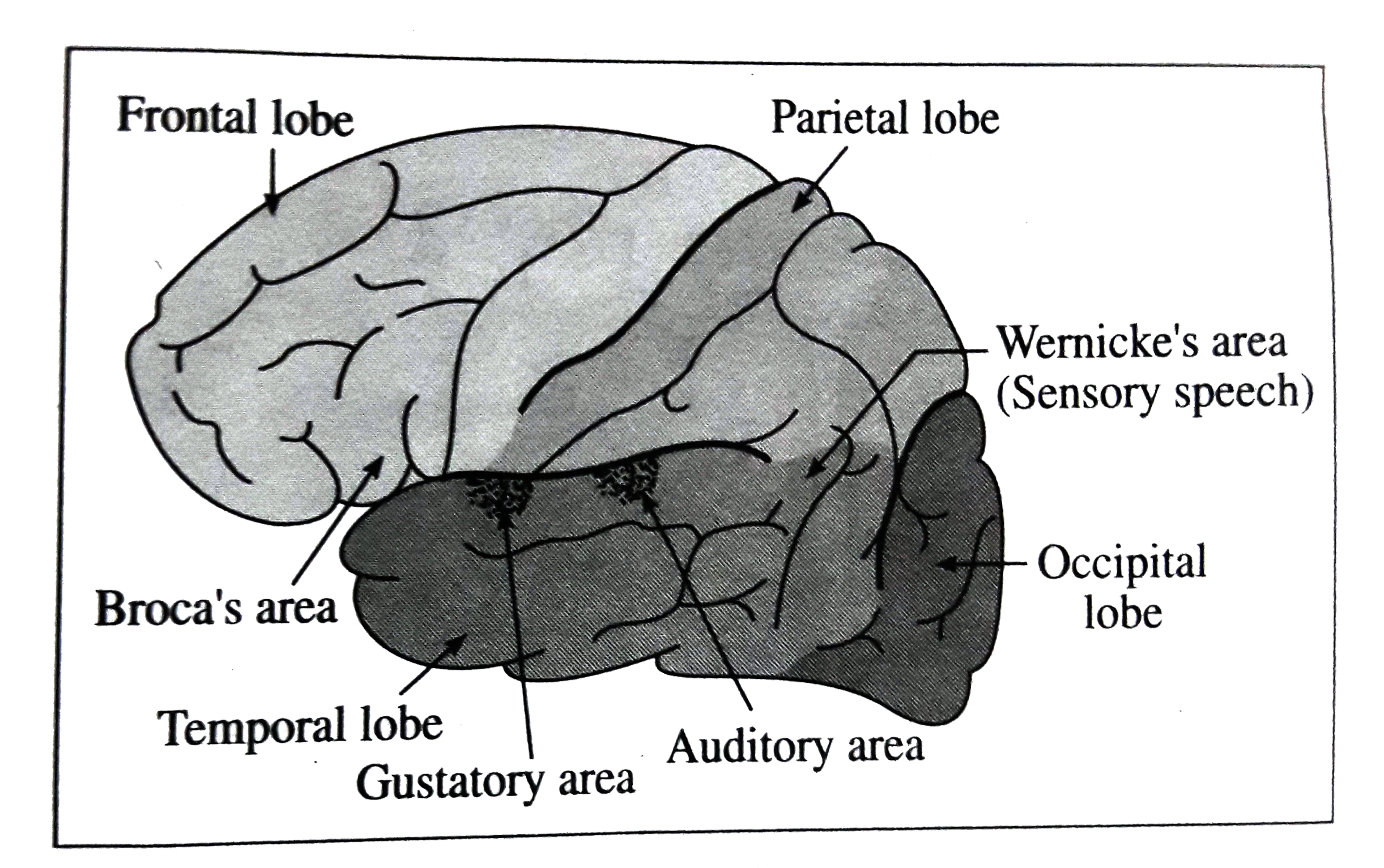With the help of labelled diagram of lateral view of cerebrum. Describe its structure and give any two functions of cerebrum.
1. Structure of cerebrum :
(1) Cerebrum is the largest part of the brain. It forms 80-85 % of the brain.
(2) A median longitudinal fissure divides the cerebrum into two cerebral hemispheres. These hemispheres are interspheres are interconnected by a thick band of transverse nerve fibres called corpus callosum.
(3) The outer part of cerebrum is called cortex while the inner part is called medulla.

(4) The roof of cerebrum is called pallium. Pallium is highly folded forming sulci and gyri. Sulci are depressions while gyri are ridges. The gyri increase the surface area of cerebal cortex.
(5) The ventrolateral walls of cerebrum are thickened and are called corpora striata.
(6) The cerebral cortex has three deep sulci, the central , lateral and parieto-oocipital.
(7) These sulci divide the cerebral hemisphere into four lobes. These are frontal, partietal, occipital and temporal lobes.
(8) The central sulcus separates frontal and parietal lobes. the lateral sulcus separates parietal and temporal lobes and the parieto-occipital sulcus separates parietal and occipital lobe.
(9) There are three functional areas in cerebral cortex. viz., sensory, association and motor area. Sensory area analyzes the sensory inputs. Association area processes the information .Motor area sends the motor outputs.
2. Functional areas of cerebrum are :
(1) General motor area and general sensory area.
(2) Association area
(3) Broca's area
(4) Sensory speech area or Wernick's area.
The functions given below are associated with these areas .
(6) Sensory visual area
(7) Auditory area.
3. Functions of cerebrum :
(1) The cerebrum controls the voluntary activities.
(2) The cerebrum perceives various sensory stimuli received through vision. taste , smell , sound , touch , speech , etc.
(3) It is the centre of memory, willpower , intelligence resoning and learning.
(4) The cerebrum is the centre for emotions, thoughts and fellings, pain , plessure, fear, fatigue, pressure, temperature , etc.
(5) It is also the centre for micturition, defecation , weeping , laughing etc.
Topper's Solved these Questions
- LONG ANSWER QUESTIONSBOOK - NAVNEET PUBLICATION - MAHARASHTRA BOARDCHAPTER - LONG ANSWER QUESTIONSEXERCISE - Human Reproduction
8 Videos
- LONG ANSWER QUESTIONSBOOK - NAVNEET PUBLICATION - MAHARASHTRA BOARDCHAPTER - LONG ANSWER QUESTIONSEXERCISE - Additional Important Questions for Self-practice
1 Videos
- LONG ANSWER QUESTIONSBOOK - NAVNEET PUBLICATION - MAHARASHTRA BOARDCHAPTER - LONG ANSWER QUESTIONSEXERCISE - Excretion and Osmoregulation
2 Videos
- GIVE REASONS BOOK - NAVNEET PUBLICATION - MAHARASHTRA BOARDCHAPTER - GIVE REASONS EXERCISE - Organisms and Environment - II
2 Videos
- MATCH THE COLUMNS/MATCH THE PAIRS/COMPLETE THE TABLEBOOK - NAVNEET PUBLICATION - MAHARASHTRA BOARDCHAPTER - MATCH THE COLUMNS/MATCH THE PAIRS/COMPLETE THE TABLEEXERCISE - Chapter 19 : Organisms and Environment - II
3 Videos
Similar Questions
Describe the functional areas of Cerebrum.
View SolutionWith the help of a labelled diagram describe the internal structure of human heart.
View SolutionWith the help of a labelled diagram give the structure of DNA-double helix.
View SolutionDescribe the structure of cerebrum add a note on its functions.
View SolutionWith the help of well labelled diagram describe the internal structure of human heart .
View SolutionWith the help of a labelled diagram, describe the structure of typical anatropous ovule.
View SolutionWith the help of well labelled diagrams describe the structure of a typically bacterial cell.
View SolutionWhat the help of a labelled diagram describe the structure of a chloroplast.
View SolutionWith the help of a suitable diagram, describe the structure and function of a neuron.
View SolutionDescribe various lobes of cerebrum of human brain and their functions.
View Solution
